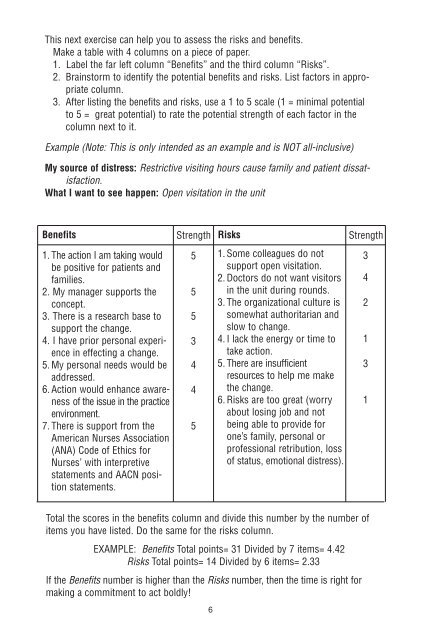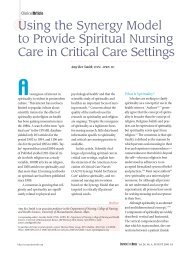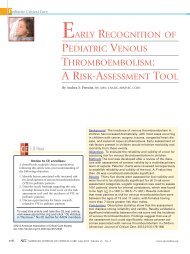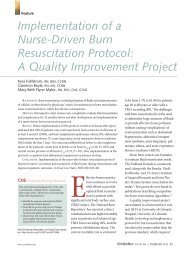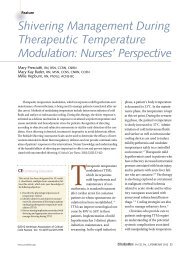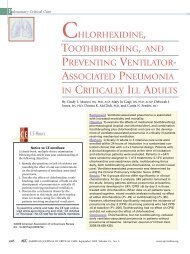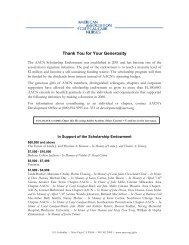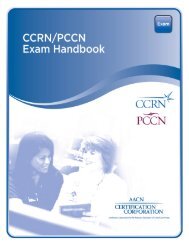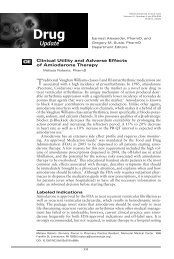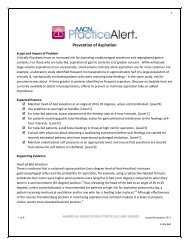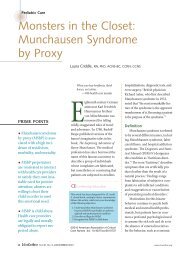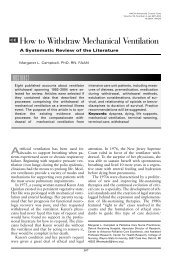The 4A's to Rise Above Moral Distress - American Association of ...
The 4A's to Rise Above Moral Distress - American Association of ...
The 4A's to Rise Above Moral Distress - American Association of ...
Create successful ePaper yourself
Turn your PDF publications into a flip-book with our unique Google optimized e-Paper software.
This next exercise can help you <strong>to</strong> assess the risks and benefits.<br />
Make a table with 4 columns on a piece <strong>of</strong> paper.<br />
1. Label the far left column “Benefits” and the third column “Risks”.<br />
2. Brains<strong>to</strong>rm <strong>to</strong> identify the potential benefits and risks. List fac<strong>to</strong>rs in appropriate<br />
column.<br />
3. After listing the benefits and risks, use a 1 <strong>to</strong> 5 scale (1 = minimal potential<br />
<strong>to</strong> 5 = great potential) <strong>to</strong> rate the potential strength <strong>of</strong> each fac<strong>to</strong>r in the<br />
column next <strong>to</strong> it.<br />
Example (Note: This is only intended as an example and is NOT all-inclusive)<br />
My source <strong>of</strong> distress: Restrictive visiting hours cause family and patient dissatisfaction.<br />
What I want <strong>to</strong> see happen: Open visitation in the unit<br />
Benefits<br />
1. <strong>The</strong> action I am taking would<br />
be positive for patients and<br />
families.<br />
2. My manager supports the<br />
concept.<br />
3. <strong>The</strong>re is a research base <strong>to</strong><br />
support the change.<br />
4. I have prior personal experience<br />
in effecting a change.<br />
5. My personal needs would be<br />
addressed.<br />
6. Action would enhance awareness<br />
<strong>of</strong> the issue in the practice<br />
environment.<br />
7. <strong>The</strong>re is support from the<br />
<strong>American</strong> Nurses <strong>Association</strong><br />
(ANA) Code <strong>of</strong> Ethics for<br />
Nurses’ with interpretive<br />
statements and AACN position<br />
statements.<br />
Strength Risks<br />
Strength<br />
5<br />
5<br />
5<br />
3<br />
4<br />
4<br />
5<br />
6<br />
1. Some colleagues do not<br />
support open visitation.<br />
2. Doc<strong>to</strong>rs do not want visi<strong>to</strong>rs<br />
in the unit during rounds.<br />
3. <strong>The</strong> organizational culture is<br />
somewhat authoritarian and<br />
slow <strong>to</strong> change.<br />
4. I lack the energy or time <strong>to</strong><br />
take action.<br />
5. <strong>The</strong>re are insufficient<br />
resources <strong>to</strong> help me make<br />
the change.<br />
6. Risks are <strong>to</strong>o great (worry<br />
about losing job and not<br />
being able <strong>to</strong> provide for<br />
one’s family, personal or<br />
pr<strong>of</strong>essional retribution, loss<br />
<strong>of</strong> status, emotional distress).<br />
Total the scores in the benefits column and divide this number by the number <strong>of</strong><br />
items you have listed. Do the same for the risks column.<br />
EXAMPLE: Benefits Total points= 31 Divided by 7 items= 4.42<br />
Risks Total points= 14 Divided by 6 items= 2.33<br />
If the Benefits number is higher than the Risks number, then the time is right for<br />
making a commitment <strong>to</strong> act boldly!<br />
3<br />
4<br />
2<br />
1<br />
3<br />
1


